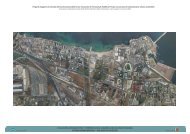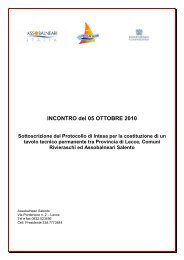Water Wall ® della Technofluids S.r.l. - AmbienteAmbienti
Water Wall ® della Technofluids S.r.l. - AmbienteAmbienti
Water Wall ® della Technofluids S.r.l. - AmbienteAmbienti
You also want an ePaper? Increase the reach of your titles
YUMPU automatically turns print PDFs into web optimized ePapers that Google loves.
ENERGY SAVING - OILY WASTEWATER TREATMENT - METALWORKING FLUIDS RECOVERY - POLLUTED OIL RECLAMATION<br />
COSA FA<br />
Mediante un processo costituito da una precisa sequenza<br />
di specifiche tecnologie, rimuove dai fludi refrigeranti tutte<br />
le particelle solide e liquide disperse nel fluido quali:<br />
- Residui di polveri di lavorazione (fino a 0,5 µ)<br />
- Olii estranei all’emulsione (olii idraulici, olii guide, etc.)<br />
- Sporcizia derivante dalla lavorazione<br />
Oltre a tutto questo, e non meno importante, il sistema<br />
<strong>Water</strong><strong>Wall</strong> controlla, inibendola, la proliferazione dei batteri<br />
anaerobici che si formano nell’emulsione durante la<br />
sua permanenza nelle vasche di raccolta.<br />
UTILITÀ<br />
Aumento <strong>della</strong> durata del refrigerante<br />
mediante l’utilizzo del sistema <strong>Water</strong><strong>Wall</strong> è possibile<br />
prolungare la durata del refrigerante fino a 2 anni (e oltre)<br />
sempre al massimo dell’efficacia.<br />
Aumento <strong>della</strong> qualità <strong>della</strong> lavorazione<br />
attraverso l’eliminazione del pulviscolo (fino a 0,5 µ)<br />
disperso nell’acqua. Se non eliminato questo potrebbe arrivare<br />
a trovarsi nel punto di contatto tra pezzo e utensile,<br />
compromettendo la qualità <strong>della</strong> finitura <strong>della</strong> lavorazione<br />
(oltre alla qualità e alla durata dell’utensile).<br />
Aumento <strong>della</strong> durata degli utensili<br />
eliminando gli olii estranei (olio guide – olio idraulico) non<br />
miscelati all’emulsione e micronizzati dalla pompa centrifuga<br />
<strong>della</strong> vasca di raccolta. Queste particelle, trovandosi nel<br />
punto di contatto tra utensile e materiale durante la lavorazione,<br />
a causa del calore sprigionato dall’attrito fondono<br />
creando particelle di carbonio che si fissano sugli utensili,<br />
limitandone la durata e la qualità <strong>della</strong> finitura.<br />
Miglioramento delle condizioni ambientali<br />
eliminando i batteri anaerobici che si sviluppano durante<br />
la permanenza dell’emulsione nella vasca di raccolta e che<br />
sono responsabili di infezioni all’apparato respiratorio e<br />
urinario.<br />
Minori volumi di refrigerante in acquisto e in smaltimento<br />
grazie al prolungamento <strong>della</strong> durata del refrigerante<br />
diminuiscono i volumi, facendo calare considerevolmente<br />
i costi di smaltimento e facilitando la gestione e la tenuta<br />
degli appositi registri.<br />
WHAT IT DOES<br />
By a process made by a precise sequence of spefical technologies,<br />
it removes from cooling fluids all solid and liquid<br />
particles dispersed on the fluid like:<br />
- Residual of swarfs and fines (up to 0,5 µ)<br />
- Tramp oil (hydraulic oils, guide’s oil, etc.)<br />
- Dirty given by the metalworking process<br />
Furthermore, and not less important, the <strong>Water</strong><strong>Wall</strong> system<br />
controls, inhibiting it, the growt of anaerobic bacteria that<br />
feed upon the coolant during its stay inside the collecting<br />
tanks.<br />
UTILITY<br />
Increase of coolant life<br />
by using the <strong>Water</strong><strong>Wall</strong> system it is possible to extend the life<br />
of the coolant up to 2 years (and more) always at the maximum<br />
performance capacity.<br />
Enhancement of the production quality<br />
by removing the powders (up to 0,5 µ) dispersed on the<br />
water. If not removed this could arrive on the contact side<br />
between piece and tool, compromising the quality of the<br />
process finishing (further to the quality and the life of the<br />
tool).<br />
Extension of the tool’s life<br />
removing the tramp oil (guides oil – hydraulic oil) not mixed<br />
in the coolant and micronized by the centrifugal pump of the<br />
collecting tank. When these particles arrive in the contact<br />
point between tool and material, cause of the<br />
heat given by the friction, they melt creating carbon particles<br />
that fix on the tools, limiting their life and the finishing quality.<br />
Improvement of the ambient conditions<br />
removing the anaerobic bacteria that grow during the<br />
permanence of the coolant inside the collecting tank and<br />
that are responsibles of infections on respiratory and urinary<br />
apparatus.<br />
Lower volumes of coolants to buy and to dispose of<br />
thanks to the increased coolant life, the volumes considerably<br />
decrease, lowering as consequence the disposal costs and<br />
making easier the management of the relevant loogbooks.




